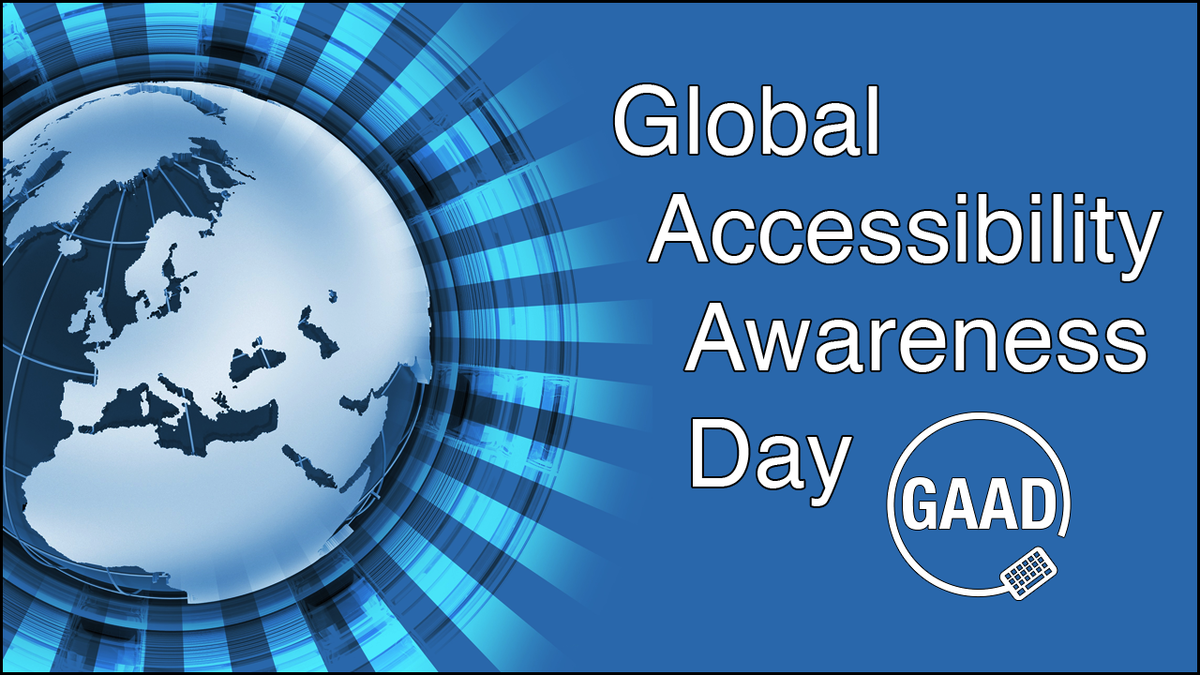Global Accessibility Awareness Day (GAAD) is a community-driven worldwide effort. It is marked annually on the third Thursday of May and is dedicated to:
raising the profile of and introducing the topic of digital (web, software, mobile app/device etc.) accessibility and people with different disabilities to the broadest audience possible.
Why an Accessibility Awareness Day?
Accessibility is often the last thing on web content authors, designers, developers, and technology procurers minds.
If:
- you are in fairly decent health, with good eyesight and good hearing;
- you don't have any cognitive or learning issues, has the full range of motor skills;
- you are reasonably well educated and pretty good at using a computer;
- most of the people you meet every day are more or less like yourself, and nothing much gets in the way;
Then:
It can be easy to forget that a lot of people aren't like this and that some of these people are those who may have trouble using their web page, site, or application.
Ideas for Celebrating
Pick one or more!
- Throw Your Mouse Out the Window. Accessibility for people who are physically unable to use a mouse is just one of many web accessibility issues. But it is perhaps the easiest to test.
- Experience motor loss by switching your mouse to your non-dominant hand for an hour.
- Experience the web without images. Turn off images in your browser and surf the web for an hour.
- Experience reduced vision. Dim the screen on your mobile phone and use it in bright sunlight.
- Experience video without sound by turning it off.
- Surf the web with a screen reader for an hour using one of the following:
- Introduce yourself to the subject of accessibility with Accessibility 101. Topics include the What, Who, Why, How, and When of web accessibility.
- Dive in deeper by learning how structure makes a document more inclusive and by learning how text alternatives make images more accessible.
- Learn about WCAG Principles and Implementation.
- Check out the WCAG 2.2 Public Working Draft.
- Get Web Accessibility News First. Subscribe to the Web Design Update Newsletter and receive accessibility information first in each issue.
- Watch Online Accessibility Training Videos provided at no cost to University of Minnesota students, faculty, and staff.
- Get your questions answered about PDF Accessibility. Learn the the what, when, why, and how.
- Honor diversity and practice inclusion by making your email messages more accessible with 5 Email Accessibility Tips.
- Learn how the Social Model of Disability is a way of understanding access issues and how to treat all members of society as equal.
- Be aware of Google Sites Accessibility barriers and work-arounds.
- Learn how accessibility impacts people with disabilities and benefits everyone in Web Accessibility: Essential for Some, Useful for All.
- Become aware of 6 Accessibility Myths.
- Watch a series of short videos that provide a fun way to learn core accessibility skills in AccessibleUooza.
- Learn Accessibility Core Skills.
- Watch a Video Introduction to Web Accessibility and W3C Standards.
- Watch a fun, upbeat video and find out about the Benefits of Captioning.
- Learn about the importance of captions, how to caption, and captioning best practices in 4 short videos in a YouTube Video Series About Captioning.
- Discover how to solve a major issue for captioning 3rd party videos in Captioning Challenges When Someone Else Owns the Copyright.
- Learn how to make accessible media with a great educational resource from the W3C Web Accessibility Initiative: Making Audio and Video Media Accessible.
- Learn how audio description is not a novelty, but as necessary to a person with visual disabilities as captioning is to a person who is Deaf or hard-of-hearing in Audio Description for Inclusive Video.
- Learn about Read&Write Gold software, which was developed primarily to assist students with print disabilities, but has the capacity to help all individuals succeed.
- Use the Canvas accessibility tool, UDOIT to help you to identify and fix accessibility issues in Canvas course content.
- Test a page of a website with an accessibility tool such as the WAVE.
- Go to https://wave.webaim.org/.
- Enter your web page URL.
- Hit your enter or return button to get feedback on the page's accessibility.
- Test a website with the Functional Accessibility Evaluator (FAE) Tool.
- Browse the Web Design Update archives:
- Volume 14, Issue 09 August 27, 2015 and onward.
- Mailman archives: Volume 4, Issue 06, August 4, 2005 through Volume 14, Issue 08, August 20, 2015 (815 Issues)
- First 162 Issues: (Volume 1, Issue 01, July 2002, through Volume 4, Issue 05, July 2005) and subsequent issues are available as text files.
- Visit the Web Design Reference site, a mega-reference (over 6,000 links) of information and articles about web design and development. The majority of its specific accessibility info is listed at:
- Accessibility
- Accessibility Statements
- Assistive Technology
- Benefits (Why accessibility?)
- Buttons
- CAPTCHA (Completely Automated Public Turing test to tell Computers and Humans Apart).
- Carousels
- Check Lists
- Cognitive Disabilities
- Definitions and Overviews
- Flicker
- Focus
- Forms
- Language
- Law, Lawsuits, Policies
- Mobile
- Multimedia:
- Plugins, PDF, PowerPoint, etc
- Relative Sizing
- Structure
- Style Sheets
- Tables
- Testing, Checking, Validating
- Text Alternatives/Equivalents
- Text Links
- Text Only Versions
- Usability and Accessibility
- Accessibility Books
- Accessibility of JavaScript and Accessible Rich Internet Applications (ARIA)
- Accessibility Tools
- Color Accessibility
- Drupal Accessibility
- Landmark Roles
- Skip Links
- Accessibility
